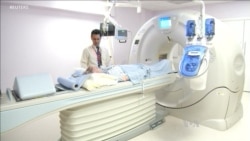ນຶ່ງໃນຄວາມເຊື່ອໝັ້ນ ຂອງຂັ້ນຕອນ ການແກ້ໄຂບັນຫາທາງຄອມພິວເຕີ ແລະ ຂະ
ບວນການວິເຄາະຂໍ້ມູນ ກໍແມ່ນຄວາມສາມາດຂອງມັນ ທີ່ຈະກັ່ນກອງ ຂໍ້ມູນໃໝ່ ອອກ
ມາຈາກເທັກໂນໂລຈີເກົ່າ. ຕົວຢ່າງເຊັ່ນ ບັນດາແພດໝໍ ຢູ່ມະຫາວິທະຍາໄລ ລອນ
ດອນ ໃນນະຄອນ ອັອກສຝອດ ໄດ້ຄົ້ນຄິດວິທີ ທີ່ຈະທຳການຖ່າຍ ເອັກສເຣ ຫົວໃຈ
ແບບປົກກະຕິ ແລະ ຄາດເດົາບັນຫາຂອງຫົວໃຈໄດ້ສຳລັບຫຼາຍໆປີລ່ວງໜ້າ. ນັກ
ຂ່າວວີໂອເອ ເຄວິນ ອີນັອກສ ມີລາຍງານເລື້ອງນີ້ ເຊິ່ງ ພຸດທະສອນ ຈະນຳລາຍລະ
ອຽດມາສະເໜີທ່ານໃນອັນດັບຕໍ່ໄປ.
ຄວາມຫວັງຂອງເທັກໂນຈີໃໝ່ນີ້ ແມ່ນ ມັນສາມາດເຮັດໃຫ້ພວກຄົນເຈັບ ມີກຳລັງໃຈ
ທີ່ຈະເຮັດວຽກ ໄປສູ່ການປ້ອງກັນບັນຫາ ກ່ຽວກັບ ຫົວໃຈໃນອະນາຄົດ.
ນີ້ແມ່ນວີທີທີ່ມັນເຮັດວຽກ: ປັດຈຸບັນນີ້ ການເອັກສເຣ ແມ່ນສາມາດບອກພວກຄົນເຈັບ
ໄດ້ວ່າ ເຂົາເຈົ້າເປັນໂຣກເສັ້ນເລືອດຕີບ ທີ່ເປັນອັນຕະລາຍນັ້ນຫຼືບໍ່, ແຕ່ບອກບໍ່ໄດ້ຫຼາຍ
ໄປກວ່ານັ້ນ.
ທ່ານ ຊາຣາລຳບອສ ແອນໂຕເນຍເດສ ຈາກມະຫາວິທະຍາໄລ ອັອກສຝອດ ກ່າວວ່າ
“ຕອນນີ້ ຍ້ອນເທັກໂນໂລຈີໃໝ່ ພວກເຮົາຈຶ່ງສາມາດເຮັດໄດ້ ໄປຫຼາຍກວ່າສິ່ງດັ່ງກ່າວ
ແລະ ສາມາດເວົ້າໄດ້ວ່າ ເຈົ້າບໍ່ມີເສັ້ນເລືອດຕີບຫຼາຍ ແຕ່ເສັ້ນເລືອດນັ້ນ ໄດ້ອັກເສບ
ແລະ ການຕີບຂອງຫຼອດເລືອດກໍຈະຄ່ອຍໆປັບປຸງໃຫ້ດີຂຶ້ນ ໃນອີກ 5 ປີຕໍ່ໄປ. ສະນັ້ນ
ບາງເທື່ອ ຖ້າເຈົ້າສາມາດເລີ່ມເອົາຂະບວນການປ້ອງກັນໄດ້, ບາງທີເຈົ້າຈະເລີ່ມກິນຢາ,
ກິນຢາພິເສດຕື່ມອີກ, ເພື່ອຫຼີກເວັ້ນການກໍ່ຕົວຂອງໄຂມັນຢູ່ໃນເສັ້ນເລືອດ, ເຊິ່ງແມ່ນ
ພະຍາດ.”
ບັນດານັກຄົ້ນຄວ້າເວົ້າວ່າ ຄວາມສາມາດທີ່ຈະລະບຸການອັກເສບຢູ່ອ້ອມຮອບເສັ້ນ
ເລືອດລ່ວງໜ້າ ແມ່ນນະວັດຕະກຳໃໝ່ ໃນການຕໍ່ສູ້ ເພື່ອປ້ອງກັນໂຣກຫົວໃຈ.
ທ່ານ ຊາຣາລຳບອສ ກ່າວວ່າ “ສິ່ງທີ່ຫຍຸ້ງຍາກ ໃນການກວດຫາໂຣກໃນຫຼອດເລືອດ
ຫົວໃຈ ແມ່ນການຫາວິທີ ທີ່ຈະລະບຸການອັກເສບໃນ ຫຼອດເລືອດຂອງຫົວໃຈ ຍ້ອນວ່າ
ນີ້ແມ່ນສິ່ງທີ່ພວກເຮົາໄດ້ພະຍາຍາມ ທີ່ຈະບັນລຸໃນ 50 ປີທີ່ຜ່ານມາ. ເພາະວ່າຖ້າເຈົ້າ
ສາມາດທີ່ຈະບັນລຸການອັກເສບ ໃນຫຼອດເລືອດຂອງຫົວໃຈແລ້ວ ເຈົ້າກໍຈະສາມາດ
ເວົ້າໄດ້ວ່າ ຫຼອດເລືອດເສັ້ນໃດຈະຜະລິດໄຂມັນ, ພະຍາດ, ເຊິ່ງຫຼອດເລືອດຈະເຮັດ
ໃຫ້ເປັນໂຣກຫົວໃຈ.
ບັນດານັກຄົ້ນຄວ້າ ອັອກສຝອດ ເຊື່ອວ່າ ວຽກງານ ຂອງເຂົາເຈົ້າ ສາມາດທີ່ຈະບົ່ງ
ບອກຈຳນວນຄົນໄດ້ ຫຼາຍເຖິງ 30,000 ຄົນ ຜູ້ທີ່ມີຄວາມສ່ຽງຕໍ່ການເປັນໂຣກຫົວໃຈ.
ທ່ານ ຊາຣາລຳບອສ ກ່າວວ່າ “ໃນ ອັງກິດ ພວກເຮົາມີຄົນເປັນໂຣກຫົວໃຈວາຍ
100,000 ຄົນ ໃນທຸກໆປີ. ດ້ວຍເທັກໂນໂລຈີໃໝ່ນີ້, ເຖິງແມ່ນພວກເຮົາຈະຍັງບໍ່ໄດ້
ກະປະມານຕົວເລກທີ່ແນ່ນອນ ກ່ຽວກັບ ໂຣກຫົວໃຈທີ່ພວກເຮົາສາມາດປ້ອງກັນໄດ້
ເທື່ອນັ້ນກໍຕາມ, ແຕ່ພວກເຮົາກໍອາດມີຄວາມເປັນໄປໄດ້ ທີ່ຈະລະບຸຄົນໄດ້ເຖິງ 20 ຫຼື
30 ເປີເຊັນ ກ່ອນທີ່ເຂົາເຈົ້າຈະເປັນໂຣກຫົວໃຈ ຍ້ອນວ່າ ຄົນພວກນີ້ ແມ່ນຜູ້ທີ່ໄດ້ທຳ
ການກວດເອັກສເຣ ທີ່ມີຢູ່ໃນສ່ວນນຶ່ງ ຂອງການປິ່ນປົວສຸຂະພາບ.
ການເປັນໂຣກຫົວໃຈ ແລະ ອຳມະພຶກນຳກັນ ແມ່ນສາເຫດທີ່ນຳໜ້າໝູ່ໃນການເສຍ
ຊີວິດຢູ່ໃນທົ່ວໂລກ.
One of the joys of computer algorithms and machine learning is their ability to extract new data from old technologies.Doctors at the University of London in Oxford for instance have figured out a way to take regular CT heart scans and predict heart problems years in advance.VOA's Kevin Enochs reports.
The hope of this new technology is that it can empower patients to work towards preventing future heart troubles.
Here is how it works: currently CT heart scans can easily tell patients if they have dangerous narrowing of their arteries, but not much more.
"Now with the new technology we can take it beyond that and can say you do not have a significant narrowing of the arteries but your arteries are inflamed and a narrowing will be developed five years down the line.So maybe you can start preventing measures, maybe you start taking tablets, extra tablets, to avoid this formation of the plaques in the arteries, the disease."
Researchers say being able to identify inflamation around the arteries early on is ground breaking in the fight to prevent heart attacks.
"The Holy Grail in cardiovascular diagnostics was to find a way to identify inflammation in the heart arteries because this is what we have been trying to achieve for the last 50 years.Because if you are able to identify inflammation in the arteries of the heart then you can say which arteries will develop plaques, disease, and which arteries will cause heart attacks.
Oxford researchers believe their work could identify as many as 30,000 people a year who are at future risk for a heart attack.
"In [Britain] we have 100,000 heart attacks every year.With this new technology, although we have not estimated the exact number of heart attacks that we can prevent, we could potentially identify at least 20 or 30 percent of the people before they have the heart attack simply because these are the people who have the scans available as part of clinical care."
Heart disease and stroke together make up the leading cause of death around the world.





